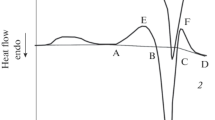Summary
A calorimetric study of first order transitions in the specific heat of PVC is reported. The results show that various types of commercial PVC exhibit a melting range which starts at about 150 °C and extends into the thermal decomposition region. A heat of fusion of 750 cal/mole was calculated from the melting energy and the change in density upon melting. A similar melting range starting at 180 °C was found in PVC polymerized at −30 °C. Once melted, this primary cristallinity does not reappear after annealing. It can be restored by dissolution and subsequent careful precipitation.
Annealing above the glass transition produces secondary crystallinity which melts just above the annealing temperature and has a heat of fusion of only about 200 cal/mole. The secondary crystallinity is not formed unless the primary crystallinity has at least partly been eliminated by prior heating. Secondary crystallinity was also found in plasticized PVC. For compounds containing 30 parts of DOP per 100 parts of PVC, storage at room temperature means annealing above the glass transition. Consequently, secondary crystallinity is formed during storage at room temperature, which accounts for the stiffening of plasticized compounds in the course of time.
Zusammenfassung
Übergänge erster Ordnung in der spezifischen Wärme von PVC wurden untersucht. Mittels kalorimetrischer Messungen wurde an Mustern verschiedener handelsüblicher PVC-Sorten ein Schmelzbereich festgestellt, der sich von etwa 150 °C bis in das thermische Zersetzungsgebiet erstreckt. Aus Schmelzenergie und Veränderung der Dichte beim Schmelzen ließ sich die Schmelzwärme zu etwa 750 cal/Mol berechnen. Bei −30 °C polymerisiertes PVC zeigt einen ähnlichen Schmelzbereich, der aber erst bei etwa 180 °C anfängt. Diese primäre Kristallinität kann, wenn einmal geschmolzen, durch Tempern nicht wieder hergestellt werden. Wenn man das Material löst und anschließend langsam ausfällt, bildet sich die primäre Kristallinität zurück.
Tempern oberhalb der Einfriertemperatur ergibt jedoch eine sekundäre Kristallinität, deren Schmelzbereich etwas oberhalb der Tempertemperatur anfängt. Für diese Schmelzwärme wurde ein Wert von etwa 200 cal/Mol ermittelt. Diese sekundäre Kristallinität bildet sich nur dann, wenn die primäre Kristallinität vorher wenigstens teilweise geschmolzen wird. Auch in weichgemachtem PVC läßt sich die sekundäre Kristallinität beobachten. Bei einem Gemisch von 30 Teilen DOP auf 100 Teile PVC bedeutet Lagern bei Raumtemperatur ein Tempern oberhalb der Einfriertemperatur. Die sich dabei bildende Kristallinität verursacht im Laufe der Zeit eine Versteifung der Masse.
Similar content being viewed by others
References
Pezzin, G., N. Gligo, J. Appl. Polymer Sci. 10, 1 (1966).
Kratochvil, P., V. Petrus, P. Munk, M. Bohaanecký, K. Solc, J. Polymer Sci. C 16, 1257 (1967).
Berens, A. R., V. L. Folt, Trans. Soc. Rheology 11, 95 (1967).
Vidyaikina, L. I., N. A. Okladnov, B. P. Shtarkman, Vysokomol, Soyed 8, 390 (1966), Polymer Sci. USSR 8, 425 (1966).
Kaltwasser, H., F. Krause, H. Grohn, Plaste u. Kautschuk 13, 129 (1966).
Natta, G., P. Corradini, J. Polymer Sci. 20, 262 (1956).
Nardi, V., Nature 191, 563 (1961).
Mammi, M., V. Nardi, Nature 199, 247 (1963).
Lebedev, V. P., N. A. Okladnov, M. N. Shlykova, Vysokomol, Soyed A 9, 495 (1967); Polymer Sci. USSR 9, 553 (1967).
Anagnostopoulos, C. E., A. Y. Corau, H. R. Gamrath, J. Appl. Polymer Sci. 4, 181 (1960).
Nakajima, A., H. Hamada, S. Hayashi, Makromol. Chem. 95, 40 (1966).
Kockott, D., Kolloid-Z. u. Z. Polymere 198, 17 (1964).
Clark, J. E., Polymer Eng. Sci. 7, 137 (1967).
Lebedev, V. P., N. A. Okladnov, M. N. Shlykova, Soviet Plastics 1968, 10.
McKinney, P. V., C. R. Foltz, J. Appl. Polymer Sci. 1, 1189 (1967).
Wilski, H., Kolloid-Z. u. Z. Polymere 210, 37 (1966).
Grever, Th., H. Wilski, Kolloid-Z. u. Z. Polymere 226, 46 (1968).
Lebedev, V. P., N. A. Okladnov, K. S. Minsker, B. P. Shtarkman, Polymer Sci. USSR 7, 724 (1965).
Walter, A. T., J. Polymer Sci. 13, 207 (1954).
Gisolf, J. H., Plastica 19, 430 (1966).
Author information
Authors and Affiliations
Rights and permissions
About this article
Cite this article
Juijn, J.A., Gisolf, J.H. & de Jong, W.A. Calorimetric study of first order transitions in poly(vinyl chloride). Kolloid-Z.u.Z.Polymere 235, 1157–1161 (1969). https://doi.org/10.1007/BF01542521
Received:
Issue Date:
DOI: https://doi.org/10.1007/BF01542521




